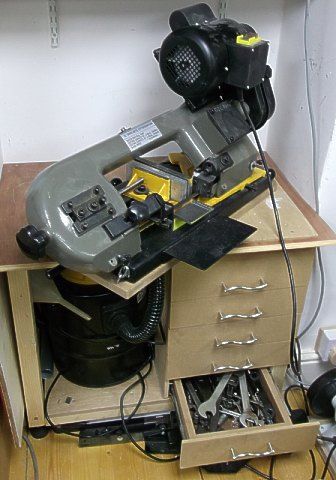Andrew
Glad you are sorted. Looks like yours was a bit better out of the box than mine if you were able to get the tracking sorted without re-making the guide adjusters. Seems to me that the really critical thing with these saws is being able to get the guide roller bearings running nicely against the blade on both sides. If you don't have that nothing seems to behave, understandable given that this design inherently puts a lot of twist on the blade as it runs on and off the wheels. Probably rather more twist than ideal but inescapable for a machine of this size. It must make the guides work hard. Mine had significant clearance at the tightest setting, maybe 20 – 30 thou, over 1/2 mm, from memory so no chance. Its interesting to note that the larger, horizontal only, version is far less troublesome.
Probably higher price on the larger one gets a better built machine but the larger wheels must significantly reduce blade twist forces. Interestingly when I first became aware of these small H/V saws the price was much closer to that of the bigger horizontal only version. The guy who told me about them, a professional, said they were no trouble but standard blades were pretty naff. Too expensive for me at the time. Prices had pretty much halved when I finally bought, not that long after they got popular, making them much cheaper than the bigger horizontal ones. Differential has remained fairly constant since so I guess the market won't support a "good straight out of the box" version.
Agree the standard legs are useless, bordering on dangerous. I put mine on a roll around cupboard type stand about 3 ft long, 2 ft high and 13" wide using speed frame square tube for the main structure and 1 1/2 inch castors for wheels. Size dictated somewhat by material stocks. Main cupboard bit is full length, about a foot high with drop down door on the front. Hooks on the door for blade storage, space inside for one of those hand mitre saw units that were popular some time back. Upper 3" (ish) deep section takes a swarf drawer, again made to fit what I had, with a compartment at the handle end to hold the stock stop unit. Another drop down lid keeps the dust out. I always remove the stop unit for storage so the unit can slide into a smaller space with it off.
Its not ideal. Height was originally determined by the need to slide under a bench and is good for sitting on when using the saw in vertical mode but its on the low side for stock cutting. Another foot or so further up would be easier on the back when stock cutting but may well be unstable due to the narrow base and you'd probably need to sit on a stool when using in vertical mode.
Clive.
Edited By Clive Foster on 13/10/2016 11:39:11
Paul Jarvis 2.



 slotted plate with 2 countersunk holes in it. This is a table for vertical operation which I've used quite often for cutting and profiling sheet, bar and plate. Much quicker and cheaper to remove large lumps on a bandsaw than to hog it out on the mill. And cutting through a piece of 3-4" bar stock can be done while you get on with something else more critical like drinking tea.
slotted plate with 2 countersunk holes in it. This is a table for vertical operation which I've used quite often for cutting and profiling sheet, bar and plate. Much quicker and cheaper to remove large lumps on a bandsaw than to hog it out on the mill. And cutting through a piece of 3-4" bar stock can be done while you get on with something else more critical like drinking tea.





